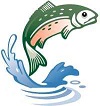
Investigation: How Do Biologists Estimate Population Size?
 Objective: You will be expected to estimate the size of a sample population using the mark-recapture technique and compare the mark and recapture technique to other methods of population estimating.
Objective: You will be expected to estimate the size of a sample population using the mark-recapture technique and compare the mark and recapture technique to other methods of population estimating.
1. You are given the responsibility of determining the number of fish in Horseshoe Lake. Discuss with your partner how would you accomplish this task and describe in detail below.
*Lab Setup - Student groups will need a sample set of "organisms." This is a bag containing objects, like beans, small toys, a pebbles. Bags will contain between 50 and 100 items.
You can also use counting squares and have students mark them with a pen.
Random Sampling Technique
A technique called sampling can be used to estimate population size. In this procedure, the organisms in a few small areas are counted and projected to the entire area. For instance, if a biologist counts 10 squirrels living in a 200-square foot area, she could predict that there are 100 squirrels living in a 2000 square foot area. This is a simple ratio.
2. A biologist collected 50 liters of pond water and counted 10 mosquito larvae. How many larvae would you estimate to be in that pond if the total volume of water in the pond was 80,000 liters? Show work.
3. What are some problems with this technique? What could affect its accuracy?
Mark and Recapture Technique
In this procedure, biologists use traps to capture animals and mark them in some way. The animals are then returned unharmed to their environment. Over a period of time, the animals are trapped again, with researchers recording how many of the original tagged individuals are recaptured. The ratio of animals trapped with the tags and the animals trapped that were not tagged is used to estimate the overall population number.
Procedure:
- Obtain a bag that represents your population (beans, pennies, toys)
- Capture 10 “animals” by removing them randomly from the bag.
- Place a mark on them using tape or string
- Return the 10 marked “animals” to the container
- Without looking, use a scoop to recapture animals in the population. Record the number of “animals” recaptured in total and the number that have a mark on them on the data table
- Return the “animals” to the bag and repeat ten times.
DATA
| Trial # | Number Captured | Number Recaptured with Mark |
| 1 | ||
| 2 | ||
| 3 | ||
| 4 | ||
| 5 | ||
| 6 | ||
| 7 | ||
| 8 | ||
| 9 | ||
| 10 |
4. Calculations = Find your Population Estimate

Estimated Size ___________
5. Use the code-name on your bag to check with the teacher about how many “animals” are really in your population.
Name on Bag ___________________________ Actual Size _________
Analysis
6. Compare the actual size to the estimated size. Did you overestimate or underestimate?
a. Is the second estimate closer than the first one? ______
b. To get the most accurate results, you would generally do [ more / less ] trials . (circle)
7. Given the following data, what would be the estimated size of a butterfly population in Wilson Park.
A biologist originally marked 40 butterflies in Wilson Park. Over a month-long period butterfly traps caught 200 butterflies. Of those 200, 80 were found to have tags. Based on this information, what is the estimated population size of the butterflies in Wilson Park? SHOW WORK
8. He later does another capture exercise at the community garden near the high school. In this area, he captured and marked 40 butterflies. The traps in this location found 100 butterflies where 50 of them had tags. What is the population size of the butterflies at the school? SHOW WORK.
10. The department of natural resources regularly collects data on population numbers in states. Discuss reasons why population numbers would be important and how this data could be used to manage wildlife populations in the state.
Other Resources on Population Biology
Case Study - Loggerhead Turtles and Population Models - explore the number of eggs hatched and survivorship
Ecology Case Study - The Wolves of Isle Royale - population decline and reintroduction of wolves
Modeling Survivorship Curves with Bubbles - simulate survival patterns with this fun bubble activity
Random Sampling with Flowers - count the number of flowers in a grid to estimate total population size
